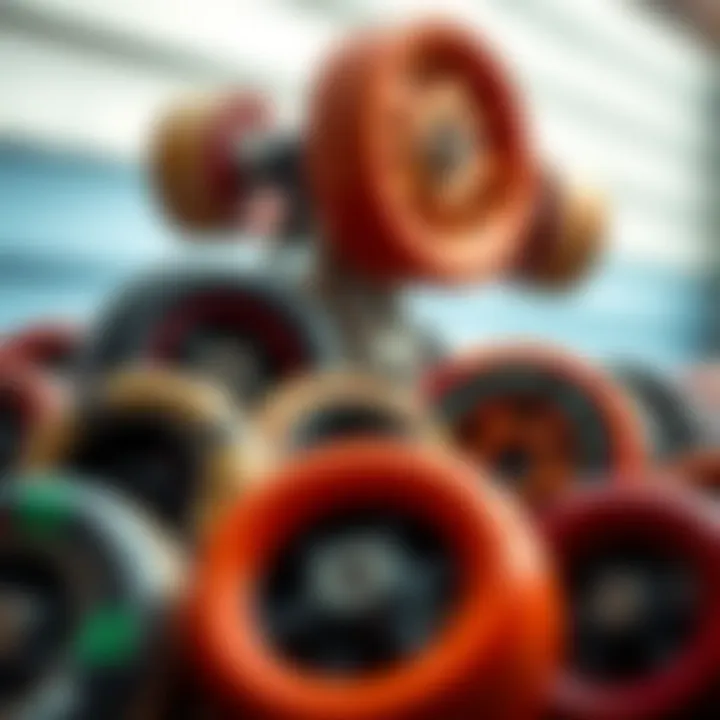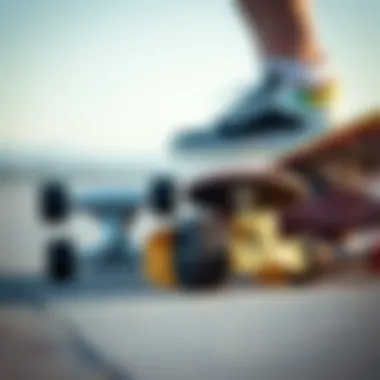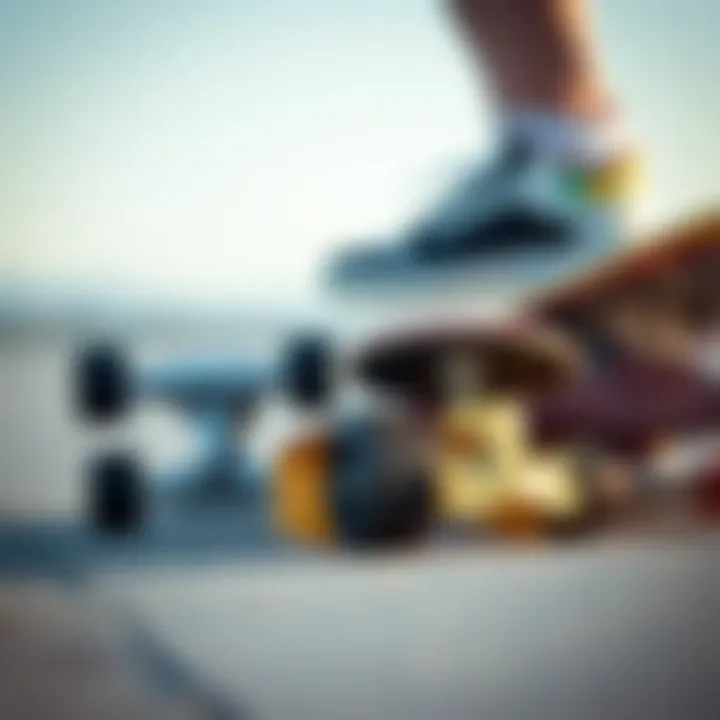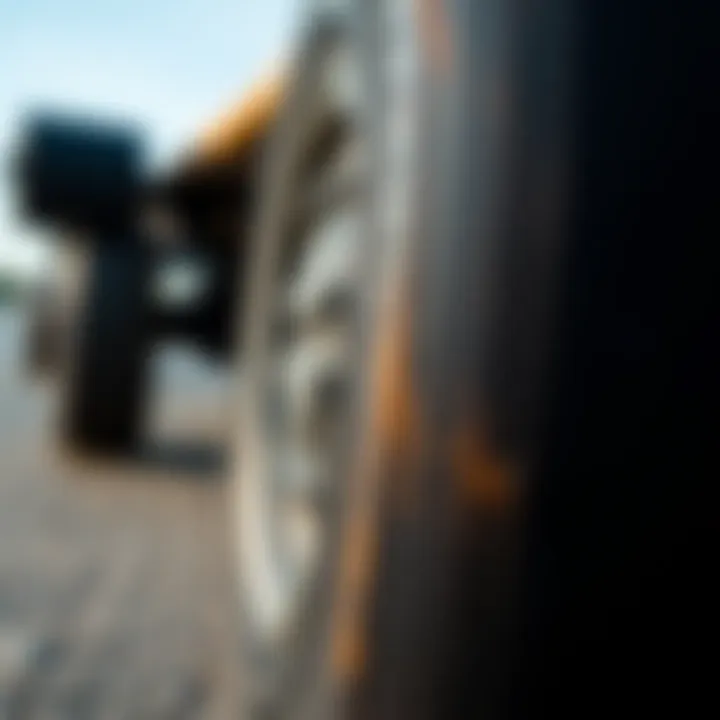Comprehensive Guide to Longboard Trucks and Wheels


Intro
Longboarding has evolved into a refined sport, with numerous enthusiasts eager to explore its various facets. At the heart of this experience lie two crucial components: the longboard trucks and wheels. Often overlooked by casual riders, these elements play a significant role in determining the overall performance, comfort, and maneuverability of a longboard.
Understanding the intricate details behind trucks and wheels isn’t just for the gearheads. Whether you’re an aspiring skateboarder or someone keen on enhancing your child’s riding skills, knowing how to select the right equipment can make a world of difference. Each ride should feel tailored to your personal style, be it cruising down a picturesque beach path or carving through steep hills.
With many options available, the task of choosing the right components may feel daunting. However, our exploration aims to strip back the complexity and present an informed discussion on the technical specifications, practical usage, and best practices for longboard trucks and wheels. Prepare to dive in as we detail their features, advantages, and the best styles suited for varying ride preferences.
As we meander through this journey, we’ll also examine how your choices can impact performance and comfort. By the end, you’ll hold a solid grasp of each aspect, making you well-equipped to tackle the open road – or skate park. Let’s lace up those shoes and roll on!
Understanding Longboarding
When it comes to longboarding, understanding the intricacies of this sport sets the stage for a rewarding experience. This section will discuss the significance of comprehending longboarding, shedding light on its core components, and how they shape your riding journey. Knowing the fundamentals not only enhances your skills but also helps you make informed choices about equipment and riding styles.
Defining Longboarding
Longboarding is more than just a pastime; it is an art form that combines balance, speed, and fluidity. At its essence, longboarding involves riding on a longer, wider board than traditional skateboards. Typically, a longboard ranges from 33 to 60 inches in length, providing stability and accommodating a variety of riding styles. It's the smooth, long-distance rides that appeal to many enthusiasts. Whether it’s cruising down city streets or carving along coastal paths, longboarding opens doors to a unique sense of freedom and connection with the surroundings.
This aspect of longboarding is central in helping both newcomers and veterans appreciate what makes their equipment special.
The Evolution of Longboards
The journey of longboarding has seen significant transformation since its inception. In the 1950s, surfers sought to mimic the feeling of riding waves on land, which led to the creation of the first longboards. Early models were quite rudimentary, made of wood and featuring simple trucks and wheels. Fast forward to the modern age, and longboards have evolved into meticulously crafted machines designed for enhanced performance and versatility.
Today, longboards come in various shapes, materials, and designs. Manufacturers prioritize not only aesthetics but also function, focusing on how trucks and wheels affect the riding experience. With advancements in technology and materials like fiberglass and carbon fiber, riders now enjoy more durability and better handling, making longboarding accessible to a wider audience than ever before.
Different Types of Longboarding Styles
Subdividing longboarding into various styles helps clarify the sport’s diverse nature. Each style emphasizes different skills and suits varied terrain. Some popular styles include:
- Cruising: Ideal for relaxed rides along boardwalks or city streets, perfect for those who appreciate a laid-back approach.
- Freeride: This style involves sliding and tricks, where riders often seek to perform spins or quick turns, demanding more control.
- Downhill: Fast-paced and exhilarating, downhill riding is for adrenaline seekers. Riders navigate slopes at high speeds, requiring skill and precision.
- Carving: This involves turning and weaving, mimicking the movements of a snowboarder. Carving is all about rhythm, and it allows for the enjoyment of a smooth, flowing ride.
- Dance: A blend of tricks and artistic expression, dancing on longboards showcases balance and footwork, turning the board into a stage.
Each longboarding style leads to distinct demands on trucks and wheels. Knowing which style resonates can guide your choices when selecting the right equipment. Understanding longboarding isn’t just about learning to ride; it's about embracing a culture that celebrates diversity, creativity, and skill within a vibrant community.
The Role of Trucks in Longboarding
When discussing longboarding, one often thinks about the aesthetics of the board or perhaps the thrill of cruising down a hill. However, the unsung heroes of the ride are the trucks. These metal components not only connect the wheels to the deck, but they play an instrumental role in how the board handles, turns, and responds to the rider’s movements. Understanding the significance of trucks can enhance your riding experience and offer a key to unlocking full potential on the board.
Anatomy of Longboard Trucks
To truly appreciate what trucks do, one needs to know their basic structure. A longboard truck typically comprises a few main parts: the baseplate, hanger, kingpin, bushings, and axle.
- Baseplate: This is the flat part mounted onto the board, providing a stable foundation. It can come in various angles, affecting how the board turns.
- Hanger: This component holds the wheels, allowing them to pivot for turning. It's where the magic happens when leaning into a turn.
- Kingpin: A hefty bolt connecting the hanger to the baseplate. The kingpin's angle can determine the truck's stiffness and responsiveness.
- Bushings: Often made of urethane, these are rubbery components that cushion the turns. Their hardness can radically alter ride dynamics.
- Axle: This is the rod that extends out from the hanger, where the wheels sit. Its length is crucial for wheel compatibility.
Getting familiar with these parts helps riders understand how adjustments can affect their setup.
Different Truck Designs
Truck design varies significantly, and each style has its strengths. One of the most notable differences lies in the geometrical design, which leads to varying turning radii and stability. Generally, you can categorize trucks into three main types:
- Standard Trucks: Simple, effective, and what most newcomers might start with. They are versatile and suit various riding styles.
- Drop-through Trucks: These allow the deck to sit between the hangers, creating a lower center of gravity which enhances stability at speed.
- Reverse Kingpin Trucks: Typically used in longboarding, they provide a tighter turning radius, ideal for slalom riding and tricks.
Choosing the right design can cater specifically to your riding style, whether you enjoy leisurely rides or are in search of adrenaline-fueled downhill runs.


Materials Used in Truck Manufacturing
Selecting the best longboard truck goes beyond just picking a stylish design or a suitable type. The materials used in construction play a significant role in performance. Most trucks are crafted from:
- Aluminum: A common choice because of its strength-to-weight ratio. It’s durable and can withstand a good beating during aggressive riding.
- Steel: Often found in the kingpin and axle, steel adds strength but can make the trucks heavier.
- Composite Materials: Some manufacturers are venturing into lighter, composite materials for bushings or special designs. These can reduce weight while maintaining resilience.
Choosing materials wisely can enhance not just your experience, but also the longevity of your gear.
How to Choose the Right Trucks for Your Board
Selecting the right trucks isn't simply about matching the color or brand with your longboard. Here's a nifty checklist you might want to consider:
- Riding Style: Determine if you’re more into cruising, downhill, or tricks. Each style may benefit from different truck types.
- Board Width: Make sure the truck axle width is compatible with your board. Aim for a truck that’s about the same width as the board for stability.
- Weight: Consider your weight as it influences performance. Heavier riders might require sturdier trucks to avoid issues.
- Budget: While it’s tempting to go for top-tier products, there are plenty of budget-friendly options that provide quality without breaking the bank.
By weighing these factors, you can find a pair of trucks that complement your longboard perfectly, ensuring an optimized ride experience.
"The right trucks can be the difference between a good ride and a great ride. Paying attention to such details can save you from fumbling your way through the learning process."
In the sprawling landscape of longboarding, trucks may not always take center stage. Nevertheless, recognizing their role is crucial for enhancing your overall experience on your longboard.
The Importance of Wheels in Longboard Performance
Wheels play a pivotal role in defining the overall ride experience of any longboard, directly impacting everything from speed to stability. Each wheel, despite appearing as a simple rubber disc, is crafted with layers of precision engineering designed to tailor the board's performance to unique riding preferences. Understanding wheels is crucial. They not only determine how smooth your ride feels on various surfaces but also dictate how well your board responds during tight turns or downhill sprints.
The fundamental factors that influence longboard wheels include the material composition, size, shape, and hardness, each crucial in their own way. If you’re looking to enhance your longboarding experience, diving into the nuances of wheels can be both enlightening and beneficial.
Overview of Longboard Wheels
Longboard wheels come in a rainbow of sizes and designs, generally ranging from 60mm to 80mm in diameter. The larger the wheel, the smoother the ride tends to be because they easily roll over small bumps and cracks in the pavement. However, there's a trade-off. Bigger wheels may slightly reduce the acceleration, which could pose a disadvantage in races or quick maneuvers.
The material often involves urethane due to its durability and grip characteristics, providing that nice blend of softness and resilience. This ensures better traction while lending itself to excellent performance on downhill runs. Plus, manufacturers continuously look to innovate the wheel's core to enhance stability.
Wheels: Hardness and Durometer Explained
When discussing wheel hardness, the durometer scale, an instrument for measuring the hardness of materials, comes into play. Most longboard wheels have a durometer rating between 78A, seen on softer wheels, and 101A, found on harder wheels. A common rule of thumb is that softer wheels (lower ratings) offer more grip and are excellent for cruising, providing a buttery smooth experience over rough terrain.
On the flip side, harder wheels are typically quicker on smooth surfaces because they experience less rolling resistance. A summary would be:
- Softer Wheels (78A - 87A): More grip, better for rough surfaces, less speed.
- Medium Hard Wheels (88A - 95A): Versatile; good for general riding conditions.
- Hard Wheels (96A - 101A): Faster, ideal for smooth pavement, less grip on rough surfaces.
Wheel Shapes and Profiles
The shape of a wheel significantly affects how it interacts with the ground. Wheel profiles vary, influencing both the maneuverability and stability of the board. Most longboard wheels fall into two major categories: square-edged and round-edged. Square-edged wheels provide better grip during turns and help with slide control, making them popular among downhill riders who value stability and clarity at high speeds. Round-edged wheels are easier to slide and often preferred by those who enjoy trick skating and sharp turns.
Furthermore, a wheel’s contact patch—the area of the tire that makes contact with the ground—affects traction. Wider contact patches generally yield more grip but can inhibit sliding, while narrow patches allow for easier sliding but potentially less grip on turns.
Choosing the Right Wheels for Your Riding Style
Selecting the right wheels hinges on understanding your intentions on the board. If you're a casual rider gliding through the park, you might choose larger, softer wheels that absorb bumps while providing comfort. However, if you’re more into downhill racing, hard wheels with a small diameter could be your go-to for that added speed.
It's crucial to match wheel specs to the riding environment:
- For cruising on pavement, go for larger, softer wheels.
- For slide tricks and skate parks, smaller, harder wheels would be more favorable.
- If you're tackling rough terrain, opt for soft wheels, which will make every crack in the asphalt seem like nothing.


"Quality wheels are not just a luxury; they are a necessity for a safe and enjoyable ride."
In summary, wheels are the lifeline of any longboard setup, and comprehension of their intricacies can greatly enrich one's skating experiences. Thus, understanding their various traits can elevate performance and comfort levels, making longboarding not just a hobby but an art form prepped for the canvas of asphalt.
Maintenance and Care for Trucks and Wheels
Keeping your longboard in prime condition isn’t just about showing off your ride; it affects how well you can maneuver, control, and enjoy your skating experience. Regular maintenance and thoughtful care can significantly extend the life of your trucks and wheels, ensuring that you don’t face unnecessary hiccups on a smooth ride. Without adequate care, even the best components can lead to inefficiencies and discomfort, not to mention safety issues.
Routine Inspection and Maintenance Practices
Routine inspection of your longboard components is essential to catch any issues before they escalate. Start with a visual check for any obvious signs of damage or wear such as cracks in the wheels or loose bolts on the trucks. Every now and then, take a moment to tighten the bolts and screws. A loose truck can lead to an unstable ride which, let’s face it, isn’t fun for anyone.
Make it a practice to give your longboard a more thorough examination every couple of weeks, especially if you ride often. Remember, prevention is better than cure.
- Check the screws and bolts: Ensure they’re properly tightened.
- Inspect the wheels for flat spots: These can cause vibrations and affect your glide.
- Examine the bushings: Worn bushings can compromise steering and stability.
Signs of Wear and When to Replace
It’s crucial to recognize when parts of your longboard have seen better days. Relying on components that are past their prime can lead to accidents or a less enjoyable experience overall. Here are key signs that your trucks and wheels may need replacing:
For Wheels:
- Flat Spots or Chips: If you feel a bump or wobble when skating, it might be time to switch those wheels out.
- Cracks: Small cracks can lead to complete wheel failure. Don’t gamble on safety.
- Significant Wear: If your wheels have lost their shape, or you can see a layer of wear, it’s usually best to replace them.
For Trucks:
- Cracked or Bent Hangars: A visible crack can shift your center of gravity, causing instability.
- Worn Bushings: If you notice a decrease in responsiveness or feel tight while turning, that’s a tell-tale sign.
Cleaning and Keeping Components in Optimal Condition
Beyond inspections and replacing worn parts, maintaining cleanliness is a key factor in your longboard’s performance. Dirt and grime can accumulate in your bearings and on your wheels, leading to sluggishness and decreased control. Regular cleaning can prevent these problems and enhance longevity.
To clean your longboard components, follow this simple process:
- Remove the wheels and trucks from the board.
- Use a soft brush to clean between the wheel and truck components to dislodge dirt.
- Rinse wheels and trucks with warm water, avoiding harsh chemicals that could damage materials.
- Dry completely before reassembling to avoid rust.
- Lubricate bearings: Apply a small amount of lubricant every few weeks to keep everything running smoothly.
Maintaining your longboard's trucks and wheels not only enhances your performance but also assures a safer riding environment. Checking and replacing worn parts or cleaning regularly can save both time and money in the long run. It’s best to treat your longboard like a trusted companion—it pays to take care of it.
Customizing Your Longboard Setup
Customizing your longboard setup is not just about aesthetics; it's about tailoring your board to fit your unique riding style, preferences, and needs. Each skater is different, and a one-size-fits-all approach can often lead to a less-than-optimal riding experience. From trucks to wheels, every component of your longboard influences how it performs on various terrains and conditions. Understanding these aspects can greatly enhance both your comfort and your performance.
The Benefits of Personalization
Personalizing your longboard can have a profound impact on your ride. Here are a few noteworthy advantages:
- Enhanced Comfort: When you customize your setup, you can choose components that align with your comfort preferences. For instance, if you prefer a smooth ride, opting for larger wheels can cushion the bumps along the road.
- Improved Performance: Selecting the right parts enables you to optimize your board’s performance. For instance, stiffer trucks provide more stability at high speeds, while softer ones lend more flexibility for cruising.
- A Unique Identity: Personalization allows you to express yourself. Whether it's selecting the patterns on your grip tape or the colors of your wheels, a customized board reflects who you are.
In essence, making your longboard your own can lead to a more fulfilling and satisfying riding experience.
Mixing and Matching Components for Optimal Performance
The art of mixing and matching components in longboarding can be likened to crafting your favorite dish. Just like the perfect recipe requires the right ingredients, an optimal longboard setup relies on finding a balance between various elements. Some key considerations include:


- Truck Type vs Riding Style: Think about what you'll primarily do. If you're primarily downhill riding, a wider truck base might provide better stability. For freestyle boarders, swift turns may require a more agile truck setup.
- Wheel Size and Durometer: Mixing wheel sizes can create interesting dynamics too. Larger wheels can add speed while smaller ones offer better control. Wheels with a softer durometer will grip better on rough surfaces, while harder wheels can slide more easily.
- Board Length Considerations: The dimensions of your longboard also dictate what components work best. Longboards that are longer often need wider trucks for stability, while shorter boards can be fitted with narrow trucks for tight turns.
By thoughtfully considering how these elements work together, you ensure that every ride is both enjoyable and suited to your style.
Trends in Longboard Customization
It's fascinating to see how longboard customization has evolved over the years. Currently, several trends are shaping how riders personalize their setups:
- Eco-Friendly Materials: More skaters are favoring sustainable options. Bamboo decks and recycled materials are becoming popular choices, reflecting a growing awareness of environmental issues.
- Artistic Expression: The trend of adding unique graphics or custom art to boards has flourished. From hand-painted designs to stickers, these personalized aesthetics are critical for many users.
- Technology Integration: More custom setups are incorporating technology, like integrated LED lights or tracking devices, appealing to tech-savvy riders who seek both style and functionality.
Being aware of these contemporary trends can help you make informed decisions when customizing your longboard. The right combination of creativity and performance can truly redefine your riding experience.
"A customized setup is not just about how it looks, but how it feels underneath you."
Whether you ride for fun or competition, understanding the nuances of longboard customization can set you apart on the road.
The Impact of Truck and Wheel Selection on Ride Experience
Selecting the right trucks and wheels can make a world of difference in how one experiences longboarding. Each component plays a crucial role, affecting factors like speed, stability, and ease of maneuvering. This section delves into the intricacies that lead to an enhanced ride experience. Understanding these nuances allows riders to tailor their setups according to their individual styles and preferences.
Influence on Stability and Control
Stability and control are paramount when it comes to navigating various terrains at differing speeds. The geometry and design of the trucks influence how narrowly or widely you turn, which can be a game-changer for riders looking to carve or perform tricks.
- Low vs High Trucks: Low trucks generally offer better stability at higher speeds, while high trucks may provide increased lean angles, allowing for sharper turns without sacrificing control.
- Width Considerations: Wider trucks often translate to a more stable ride because they distribute weight more effectively. Alternatively, narrower trucks can increase agility, making them ideal for more technical riding.
- Overall Setup: A well-balanced setup where the trucks align perfectly with the skateboard deck contributes hugely to overall ride quality. Misalignment can throw riders off balance, leading to a less enjoyable experience.
The Relationship between Wheel Size and Terrain Adaptability
Wheel size is another critical aspect that directly correlates with terrain adaptability and the ability to handle different riding conditions. Here's a closer look at how different wheel sizes interact with the surface beneath.
- Larger Wheels: Typically, larger wheels provide a smoother ride over rough surfaces. They can absorb minor bumps and cracks, which ensures a more comfortable experience. However, they are heavier and might affect acceleration.
- Smaller Wheels: Smaller wheels might struggle on uneven ground but excel in speed on smooth surfaces, providing a more responsive ride. Many riders prefer these for freestyle or tricks, where precision is key.
- Durometer Scale: In addition to size, the hardness of the wheels (measured on the durometer scale) also affects how they perform on various terrains. Softer wheels grip better on rough terrain, while harder wheels slide and roll faster on smooth surfaces.
"Choosing the right wheel size can either make you glide through the city streets or leave you bouncing over every crack in the pavement."
Balancing Comfort and Performance
Finding the sweet spot between comfort and performance is crucial for an enjoyable longboarding experience. Riders must consider their personal priorities—whether they value a plush ride or cutting-edge speed during their sessions.
- Suspension Feel: The trucks and wheels work together to create how the board feels beneath your feet. A combination of soft wheels with well-designed trucks can create a suspension-like feel, making even long sessions enjoyable on rough roads.
- Prioritizing Terrain: If a rider frequently traverses rough terrain, opting for softer wheels paired with well-engineered trucks is advisable. Conversely, those who prefer speed on smooth paths might benefit from harder wheels and a more responsive truck setup.
- Individual Riding Style: It's imperative to keep your personal riding style in mind. Some may prefer a softer ride for leisure cruising, while others may prefer the responsiveness and quick turns for tricks.
Ending
The conclusion of this article plays a pivotal role in tying together all the intricate threads of information discussed previously. Understanding the choices around longboard trucks and wheels isn't just about enhancing performance; it's about tailoring a riding experience that resonates with the individual skater's style and needs. The right selection of trucks and wheels can significantly affect factors like stability, control, and adaptability to terrain—elements that are crucial for both newcomers and seasoned riders alike.
Summary of Key Insights
In summary, we've explored various essential topics:
- The mechanics behind longboard trucks and their influence on board dynamics.
- The specific characteristics of wheels, including their hardness and shapes, and how they affect ride quality.
- Maintenance tips to ensure longevity and optimal performance of these elements.
- Customization options that allow for a personalized touch while enhancing board function.
- The intricate balance between comfort and performance that riders must navigate.
Each of these insights contributes to a comprehensive understanding of how to choose the right components for one’s longboard. The choices made in trucks and wheels are not mere technicalities; they're fundamental to the skating experience.
Final Thoughts on Truck and Wheel Selection
When it comes down to making choices about trucks and wheels, a skater should consider personal preferences and intended riding styles thoroughly. Individual styles vary significantly, from cruising along smooth paths to tackling steep mountain hills. Hence, having clarity about what fits one's riding goals is essential.
Select a wheel that complements the terrain, and a truck setup that aligns with your body mechanics for better control. The myriad options can be overwhelming, but taking a thoughtful and informed approach to selections can enhance both safety and enjoyment on the longboard. Remember, it’s not just about the ride; it’s about the journey and experiences shared along the way.
By prioritizing informed choices and caring for your setup, you can ensure that your longboarding experience remains smooth, thrilling, and, more importantly, uniquely yours. For further insights into longboard maintenance and modifications, forums like Reddit and educational resources from sites like Britannica can be useful places to dive deeper.
"The journey of a thousand miles begins with one step." Therefore, take that first step towards optimizing your longboard today.



